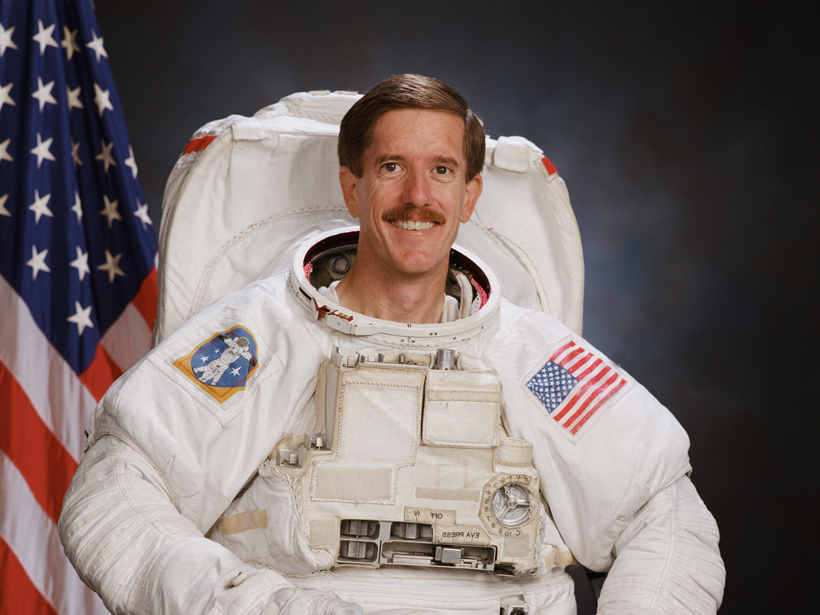A former geologist and NASA astronaut, James Reilly II, has been selected by the Trump administration to lead the U.S. Geological Survey (USGS), according to a 26 January notice from the White House.
Reilly, a former Ph.D. petroleum geologist who was educated at the University of Texas at Dallas and also holds bachelor’s and master’s degrees in the geosciences from there, currently serves the U.S. military and allied militaries as a subject matter expert on space operations. He also works as a technical adviser supporting the National Security Space Institute of the U.S. Air Force, according to the White House announcement.
Reilly, 63, flew on three NASA space shuttle missions and logged more than 853 hours in space, including five spacewalks during his 13 years at NASA from 1995 to 2008. From 1980 to 1995, he was chief geologist at Enserch Exploration, where he worked with and led evaluation teams defining areas for the company to consider for oil and natural gas leasing and exploration in the Gulf of Mexico.
Once his nomination formally takes place, Reilly will face a hearing before the Senate Committee on Energy and Natural Resources. If his nomination is approved by the committee, it will undergo a vote by the full Senate.
The Need to Stand Up for the Agency
If confirmed, Reilly would take over an agency within the Department of the Interior (DOI) that the administration targeted in 2017 for a proposed 15% budget cut.
The USGS director “must be the main champion for the bureau” within the Department of the Interior.
Marcia McNutt, president of the U.S. National Academy of Sciences and the USGS director from 2009 to 2013, told Eos that Reilly appears to have some experience in several of the mission agencies of the bureau. However, she said she does not know how strong his management credentials are. “The USGS is a large, far-flung organization with slightly different cultures in the different mission areas. It would be important that Dr. Reilly take some time to get to know the variability within the USGS,” said McNutt. The USGS director needs to have close connections with the directors of other federal agencies, the White House Office of Science and Technology Policy, and the academic community to mount a good response if confronted with natural or man-made catastrophes such as earthquakes or oil spills, she added. “Knowing what kind of expertise is needed and who has it is important,” she said.
The USGS director “must be the main champion for the bureau within DOI,” continued McNutt, who also was president from 2000 to 2002 of the American Geophysical Union, publisher of Eos. “There are many topics competing for the Secretary’s time, attention, and for the budget. The USGS director has to every day be a cheerleader at DOI for the benefit of the USGS to DOI, to the government, and to the nation. Dr. Reilly may at times need to stand up for the independence of USGS science and have his scientists’ backs.”
Maintaining and Supporting Scientific Integrity
“Having no record of leading a large, governmental, academic or scientific organization, Dr. Reilly’s leadership skills will be tested as Director of the USGS,” Stanley Finney, secretary general of the International Union of Geological Sciences, a nongovernmental scientific organization, told Eos. Finney also is a professor in the Department of Geological Sciences at California State University at Long Beach.
“The challenge for Dr. Reilly is maintaining and supporting the scientific integrity of the U.S. Geological Survey for the greater public good.”
Reilly’s education in geological sciences, career in petroleum exploration, and experiences as a NASA astronaut “have clearly demonstrated to him the value of science and given him the perspective of the Earth evolving through a 4.5 billion year history,” Finney said, adding that the management system, vision, and mission of the USGS should be maintained. “According to its mission statement, the USGS serves the Nation by providing reliable scientific information to describe and understand the Earth. The challenge for Dr. Reilly is maintaining and supporting the scientific integrity of the U.S. Geological Survey for the greater public good.”
Elizabeth Duffy, chair of the USGS Coalition, told Eos that the coalition is looking forward to working with the next USGS director. “There are many challenges facing not only USGS but many of the Nation’s science agencies and [the coalition] is committed to the continued vitality of the USGS and its ability to provide critical data and services to the [N]ation,” she noted.
—Randy Showstack (@RandyShowstack), Staff Writer
Citation:
Showstack, R. (2018), White House announces choice to head U.S. Geological Survey, Eos, 99, https://doi.org/10.1029/2018EO091761. Published on 29 January 2018.
Text © 2018. The authors. CC BY-NC-ND 3.0
Except where otherwise noted, images are subject to copyright. Any reuse without express permission from the copyright owner is prohibited.

